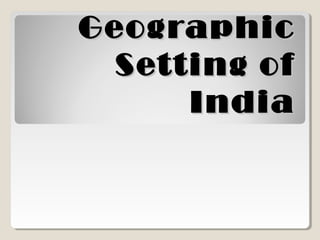
Geographic setting of india
- 2. Indian subcontinent is a large peninsula Surrounded on three (3) sides by the Arabian Sea, Indian Sea, and Bay of Bengal
- 3. In north, the Himalayan Mountain Ranges separate India from the rest of Asia Hindu Kush Mountains on the northwest also present barriers to travel
- 7. This barriers allowed first Indian civilization to develop mostly on its own, yet India was not totally isolated Indian subcontinent has diverse geographic features
- 8. Three major regions are the Northern Plain, Deccan Plateau, and Coastal Plain Three great rivers the Indus, Ganges and Brahmaputra
- 10. The chief feature of the Indian climate is the monsoon,a seasonal wind system Indus Valley covered an area larger than te Old Kingdom of Egypt (1,500 sq km)
- 11. Physical Map ofPhysical Map of IndiaIndia
- 12. The Two CitiesThe Two Cities 1. Harappa 2. Mohenjo-daro The ruins of Harappa and Mohenjo-daro revealed that they were products of careful planning Excavated were houses, granaries, and public halls, which suggest a high level of civilization
- 13. HarappaHarappa
- 16. Government andGovernment and ReligionReligion Scholars assume that a priest- king headed the government and that the rulers must have a considerable power The two cities were polytheists They also worshipped animals such as the bull and certain sacred trees
- 17. Economic LifeEconomic Life Agricultural economy thrived in the Indus Valley civilization Food surpluses supported the large population and prompted the growth of trade Merchant classes acquired wealth from trade and commerce in the cities
- 18. End of Indus ValleyEnd of Indus Valley CivilizationCivilizationFinally it ended in 1500 BCE Scholars believe that in 1500 BCE, Aryans invade Indus Valley Dravidians were the survivors of the Indus Valley civilization Their civilization, as revealed from the remains of the Mohenjo- daro, showed a static society
- 20. Geographic Setting ofGeographic Setting of Ancient ChinaAncient China Four outlaying regions Manchuria, Mongolia, Sinkiang, and Tibet surrounded the heartland of china Geographic barriers surrounds china 1.Himalayas in Tibet, world's highest mountain ranges 2.Deserts such as Gobi 3.Pacific Ocean to the east
- 26. Chinese considered themselves unique and believed that their land was at the center of the world. They called it Chung-kuo, which means the "Middle Kingdom" Huang Ho or Yellow River provides water for irrigation, fishing, and transportation
- 27. Rainful is not regular, so the area suffers from both drought and floods Chinese called this as the River of Sorrows
- 28. The ShangThe Shang CivilizationCivilization The first ruling family in china, and it survived until 1122 BCE They were political leaders They prayed made offerings
- 29. Performed sacrifices to gain good harvest They had also special powers of calling upon their ancestors
- 30. The emperor ruled over their capital city and the surrounding regions
- 32. System of WritingSystem of Writing During the shang dynasty that the chinese developed a system of wrting Early chinese wrote pictograms like the Egyptians and Sumerians
- 33. They also added ideograms as symbols that expressed ideas Under Shang dynasty, Chinese writing included over 3,000 symbols or characters
- 35. Religious BeliefsReligious Beliefs They believed that many gods and spirits lived in nature Main god is Shang-ti presided over heaven and the other gods
- 36. They believed their gods to be powerful that they could caused flood As Chief priest shang king made daily sacrifices
- 38. Shang priest also tried to tell the future A priest scratched a question on an ox bone, then he carved notches on the bone and touched the notches with a heated bronze rod. The heat caused the bone to crack.
- 39. The priest interpreted the cracks to find an answer to the question. Bones used for telling the future were called "oracle bones"
- 41. Daily LifeDaily Life Extended family was the focus of village life Family members of different generations lived in the same household Headed by the eldest male, this is because they respect their anestors and they have great respect for age and a deep feeling of duty to family
- 42. Among the royal families and nobles, men often have more than one wife Her sons were the most important Among peasant families, men normally married only one woman
